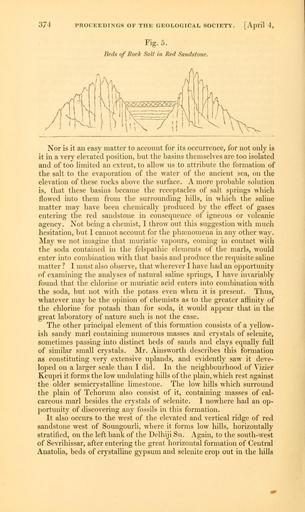MAKE A MEME
View Large Image

| View Original: | The_Quarterly_journal_of_the_Geological_Society_of_London_(12645348263).jpg (1192x1999) | |||
| Download: | Original | Medium | Small | Thumb |
| Courtesy of: | commons.wikimedia.org | More Like This | ||
| Keywords: The Quarterly journal of the Geological Society of London (12645348263).jpg 374 <br> PROCEEDINGS OF THE GEOLOGICAL SOCIETY April 4 <br> Fig 5 <br> Beds of Rock Salt in Red Sandstone <br> Nor is it an easy matter to account for its occurrence for not only is <br> it in a very elevated position but the basins themselves are too isolated <br> and of too limited an extent to allow us to attribute the formation of <br> the salt to the evaporation of the water of the ancient sea on the <br> elevation of these rocks above the surface A more probable solution <br> is that these basins became the receptacles of salt springs which <br> flowed into them from the surrounding hills in which the saline <br> matter may have been chemically produced by the effect of gases <br> entering the red sandstone in consequence of igneous or volcanic <br> agency Not being a chemist I throw out this suggestion with much <br> hesitation but I cannot account for the pheenomena in any other way <br> May we not imagine that muriatic vapours coming in contact with <br> the soda contained in the felspathic elements of the marls would <br> enter into combination with that basis and produce the requisite saline <br> matter 1 I must also observe that wherever I have had an opportunity <br> of examining the analyses of natural saline springs T have invariably <br> found that the chlorine or muriatic acid enters into combination mth <br> the soda but not with the potass even when it is present Thus <br> whatever may be the opinion of chemists as to the greater affinity of <br> the chlorine for potash than for soda it would appear that in the <br> great laboratory of nature such is not the case <br> The other principal element of this formation consists of a yellow- <br> ish sandy marl containing numerous masses and crystals of selenite <br> sometimes passing into distinct beds of sands and clays equally full <br> of similar small crystals Mr Ainsworth describes this formation <br> as constituting very extensive uplands and evidently saw it deve- <br> loped on a larger scale than I did In the neighbourhood of Vizier <br> Keupri it forms the low undulating hills of the plain which rest against <br> the older semicrystalline limestone The low hills which surround <br> the plain of Tchorum also consist of it containing masses of cal- <br> careous marl besides the crystals of selenite I nowhere had an op- <br> portmiity of discovering any fossils in this formation <br> It also occurs to the west of the elevated and vertical ridge of red <br> sandstone west of Soungourli where it forms low hills horizontally <br> stratified on the left bank of the Delhiji Su Again to the south-west <br> of Sevrihissar after entering the great horizontal formation of Central <br> Anatolia beds of crystalline gypsum and selenite crop out in the hills 35269024 109512 51125 Page 374 Text v 5 http //www biodiversitylibrary org/page/35269024 1849 Geological Society of London Biodiversity Heritage Library The Quarterly journal of the Geological Society of London v 5 1849 Geology Periodicals Smithsonian Libraries bhl page 35269024 dc identifier http //biodiversitylibrary org/page/35269024 smithsonian libraries Information field Flickr posted date ISOdate 2014-02-20 Check categories 2015 August 26 CC-BY-2 0 BioDivLibrary https //flickr com/photos/61021753 N02/12645348263 2015-08-27 10 58 01 cc-by-2 0 PD-old-70-1923 The Quarterly journal of the Geological Society of London 1849 Photos uploaded from Flickr by Fæ using a script | ||||